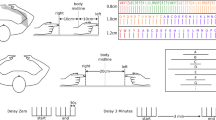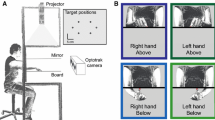Abstract
Previous work using visually guided reaches to localize landmarks on a hidden hand has suggested that proprioceptive acuity for hand targets is low and representation of hand dimensions is highly distorted (e.g., hand width estimated to be 60% wider than actual hand width). We re-examined these issues using a pure proprioceptive task in which 20 blindfolded subjects reached in a single movement without terminal corrections to touch the right index-tip to landmarks of the left hand placed in various locations in 3D space. Subjects were also tested with vision allowed to estimate minimal errors. Based on previous reports of high proprioceptive acuity for some hand landmarks, we hypothesized that the proprioceptive representation of the hand was much less distorted than described previously and that errors were not correlated with target hand location. Mean distance errors in proprioceptively guided reaches to the landmarks averaged less than 3 cm and were only 0.5–1.3 cm larger than when vision was allowed. Errors were not correlated with hand location in most subjects. Distortions of hand width averaged less than 20% wider than actual width and were not correlated with hand location in most subjects. We conclude that relatively accurate proprioceptive awareness of locations of hand/digit structures and dimensions is available for use in control of hand movements, which are executed largely subconsciously. Studying acuity of proprioception using conscious perceptual tasks and involving vision may not provide accurate measures of proprioceptive acuity as used by the motor system.





Similar content being viewed by others
Data availability
The datasets generated during and/or analyzed during the current study are available from the corresponding author on reasonable request.
References
Abend W, Bizzi E, Morasso P (1982) Human arm trajectory formation. Brain 105:331–348. https://doi.org/10.1093/brain/105.2.331
Capaday C, Darling WG, Stanek K, Van Vreeswijk C (2013) Pointing to oneself: active versus passive proprioception revisited and implications for internal models of motor system function. Exp Brain Res 229:171–180. https://doi.org/10.1007/s00221-013-3603-4
Cocchini G, Galligan T, Mora L, Kuhn G (2018) The magic hand: plasticity of mental hand representation. Q J Exp Psychol (hove) 71:2314–2324. https://doi.org/10.1177/1747021817741606
Coelho LA, Gonzalez CL (2018) The visual and haptic contributions to hand perception. Psychol Res 82:866–875. https://doi.org/10.1007/s00426-017-0870-x
Coelho LA, Gonzalez CLR (2022) Growing into your hand: the developmental trajectory of the body model. Exp Brain Res 240:135–145. https://doi.org/10.1007/s00221-021-06241-2
Coelho LA, Zaninelli G, Gonzalez CLR (2017) A kinematic examination of hand perception. Psychol Res 81:1224–1231. https://doi.org/10.1007/s00426-016-0815-9
Coffman CR, Capaday C, Darling WG (2021) Proprioceptive acuity is enhanced during arm movements compared to when the arm is stationary: a study of young and older adults. Neuroscience 466:222–234. https://doi.org/10.1016/j.neuroscience.2021.04.015
Darling WG, Hondzinski JM (1999) Kinesthetic perceptions of earth- and body-fixed axes. Exp Brain Res 126:417–430
Darling WG, Miller GF (1993) Transformations between visual and kinesthetic coordinate systems in reaches to remembered object locations and orientations. Exp Brain Res 93:534–547. https://doi.org/10.1007/BF00229368
Darling WG, Yem J (2023) Acuity of proprioceptive localization varies with body region. Neuroscience 516:100–112. https://doi.org/10.1016/j.neuroscience.2023.02.015
Darling WG, Wall BM, Coffman CR, Capaday C (2018) Pointing to one’s moving hand: putative internal models do not contribute to proprioceptive acuity. Front Hum Neurosci. https://doi.org/10.3389/fnhum.2018.00177
Dukelow SP, Herter TM, Bagg SD, Scott SH (2012) The independence of deficits in position sense and visually guided reaching following stroke. J Neuroeng Rehabil 9:72. https://doi.org/10.1186/1743-0003-9-72
Fisk JD, Goodale MA (1985) The organization of eye and limb movements during unrestricted reaching to targets in contralateral and ipsilateral visual space. Exp Brain Res 60:159–178
Gordon J, Ghilardi MF, Ghez C (1994) Accuracy of planar reaching movements. I. independence of direction and extent variability. Exp Brain Res 99:97–111. https://doi.org/10.1007/BF00241415
Ingram LA, Butler AA, Gandevia SC, Walsh LD (2019) Proprioceptive measurements of perceived hand position using pointing and verbal localisation tasks. PLoS ONE 14:e0210911. https://doi.org/10.1371/journal.pone.0210911
Lateiner JE, Sainburg RL (2003) Differential contributions of vision and proprioception to movement accuracy. Exp Brain Res 151:446–454
Liu Y, Sexton BM, Block HJ (2018) Spatial bias in estimating the position of visual and proprioceptive targets. J Neurophysiol 119:1879–1888. https://doi.org/10.1152/jn.00633.2017
Longo MR (2014) The effects of immediate vision on implicit hand maps. Exp Brain Res 232:1241–1247. https://doi.org/10.1007/s00221-014-3840-1
Longo MR (2023) Motor adaptation and distorted body representations. Trends Cogn Sci 27:9. https://doi.org/10.1016/j.tics.2022.10.006
Longo MR, Haggard P (2010) An implicit body representation underlying human position sense. Proc Natl Acad Sci USA 107:11727–11732. https://doi.org/10.1073/pnas.1003483107
Longo MR, Holmes M (2020) Distorted perceptual face maps. Acta Psychol (amst) 208:103128. https://doi.org/10.1016/j.actpsy.2020.103128
Maleki-Ghahfarokhi A, Dianat I, Feizi H, Asghari-Jafarabadi M (2019) Influences of gender, hand dominance, and anthropometric characteristics on different types of pinch strength: A partial least squares (PLS) approach. Appl Ergon 79:9–16. https://doi.org/10.1016/j.apergo.2019.04.002
Marasco PD, Hebert JS, Sensinger JW et al (2018) Illusory movement perception improves motor control for prosthetic hands. Sci Transl Med. https://doi.org/10.1126/scitranslmed.aao6990
Medina J, Duckett C (2017) Domain-general biases in spatial localization: evidence against a distorted body model hypothesis. J Exp Psychol Hum Percept Perform 43:1430–1443. https://doi.org/10.1037/xhp0000397
Paillard J (1999) Body schema and body image: a double dissociation in deafferented subjects. In: Gantchev GMS, Massion J (eds) Motor control today and tomorrow. Academic, Sofia, pp 197–214
Peviani V, Bottini G (2018) The distorted hand metric representation serves both perception and action. J Cogn Psychol 30:880–893. https://doi.org/10.1080/20445911.2018.1538154
Peviani V, Bottini G (2020) Proprioceptive errors in the localization of hand landmarks: what can be learnt about the hand metric representation? PLoS ONE 15:e0236416. https://doi.org/10.1371/journal.pone.0236416
Peviani V, Melloni L, Bottini G (2019) Visual and somatosensory information contribute to distortions of the body model. Sci Rep 9:13570. https://doi.org/10.1038/s41598-019-49979-0
Peviani V, Liotta J, Bottini G (2020) The motor system (partially) deceives body representation biases in absence of visual correcting cues. Acta Psychol (amst) 203:103003. https://doi.org/10.1016/j.actpsy.2020.103003
Proske U, Gandevia SC (2012) The proprioceptive senses: their roles in signaling body shape, body position and movement, and muscle force. Physiol Rev 92:1651–1697. https://doi.org/10.1152/physrev.00048.2011
Sergio LE, Scott SH (1998) Hand and joint paths during reaching movements with and without vision. Exp Brain Res 122:157–164. https://doi.org/10.1007/s002210050503
Soechting JF (1982) Does position sense at the elbow reflect a sense of elbow joint angle or one of limb orientation? Brain Res 248:392–395
Soechting JF, Flanders M (1989) Sensorimotor representations for pointing to targets in three-dimensional space. J Neurophysiol 62:582–594
van Beers RJ, Sittig AC, Denier van der Gon JJ (1998) The precision of proprioceptive position sense. Exp Brain Res 122:367–377
Walsh LD, Hoad D, Rothwell JC, Gandevia SC, Haggard P (2015) Anaesthesia changes perceived finger width but not finger length. Exp Brain Res 233:1761–1771. https://doi.org/10.1007/s00221-015-4249-1
Wilson ET, Wong J, Gribble PL (2010) Mapping proprioception across a 2D horizontal workspace. PLoS ONE 5:e11851. https://doi.org/10.1371/journal.pone.0011851
Worringham CJ, Stelmach GE (1985) The contribution of gravitational torques to limb position sense. Exp Brain Res 61:38–42. https://doi.org/10.1007/BF00235618
Worringham CJ, Stelmach GE, Martin ZE (1987) Limb segment inclination sense in proprioception. Exp Brain Res 66:653–658. https://doi.org/10.1007/BF00270697
Yoss AL, Zuck BI, Yem JA, Darling WG (2022) High proprioceptive acuity in slow and fast hand movements. Exp Brain Res 240:1791–1800. https://doi.org/10.1007/s00221-022-06362-2
Author information
Authors and Affiliations
Corresponding author
Ethics declarations
Conflict of interest
On behalf of all authors, the corresponding author states that there is no conflict of interest.
Additional information
Communicated by Winston D Byblow.
Publisher's Note
Springer Nature remains neutral with regard to jurisdictional claims in published maps and institutional affiliations.
Rights and permissions
Springer Nature or its licensor (e.g. a society or other partner) holds exclusive rights to this article under a publishing agreement with the author(s) or other rightsholder(s); author self-archiving of the accepted manuscript version of this article is solely governed by the terms of such publishing agreement and applicable law.
About this article
Cite this article
Darling, W.G., Zuck, B.I., Mikhail, L. et al. Proprioceptive acuity for landmarks on the hand and digits. Exp Brain Res 242, 491–503 (2024). https://doi.org/10.1007/s00221-023-06761-z
Received:
Accepted:
Published:
Issue Date:
DOI: https://doi.org/10.1007/s00221-023-06761-z




